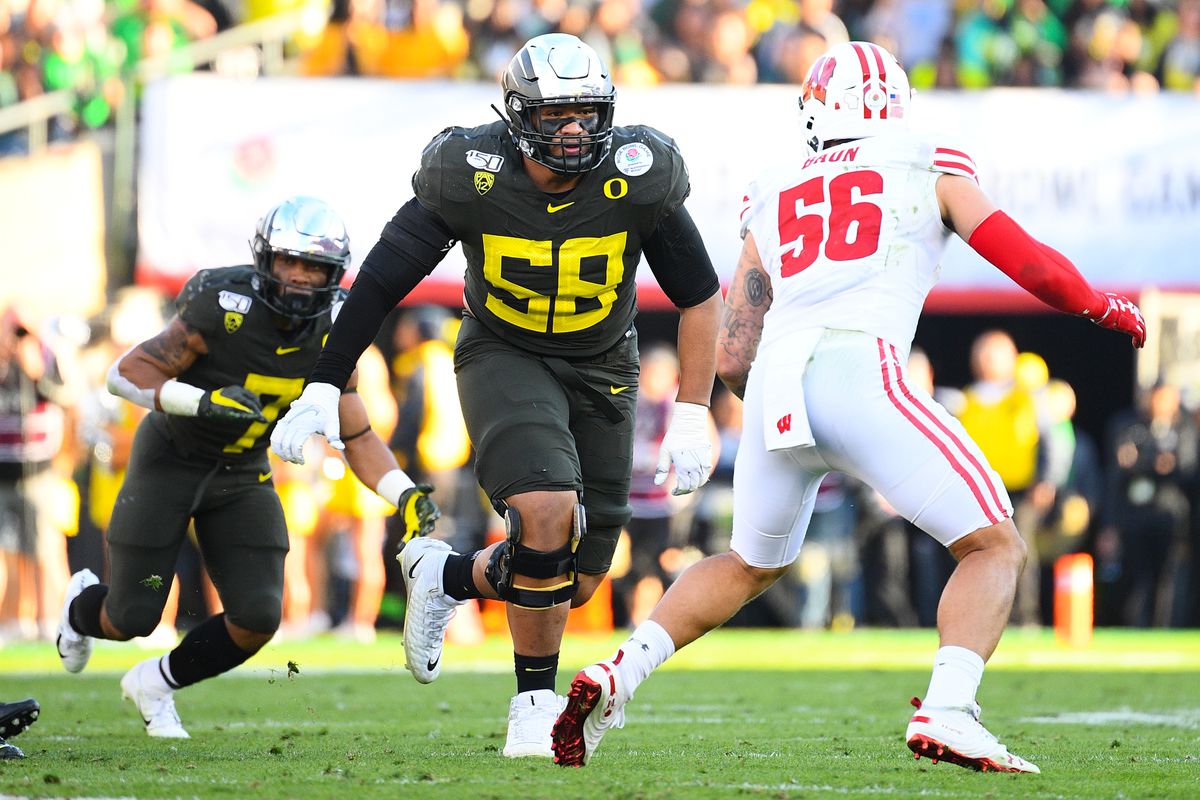Penei Sewell has been expected to the first tackle taken in the 2021 NFL Draft pretty much since the Giants turned in the card with the final selection of the 2020 NFL Draft. Of course, this could well lead to him being taken before the Panthers are on the clock with the eighth pick, with the most likely destination being the Bengals with the fifth pick, but with so much uncertainty surrounding the top ten picks this year, Sewell could also fall to the eighth pick.
The Panthers’ need at tackle is both significant and fairly evident and, for as much talk as there has been about them potentially trading down, should a tackle they rate well above the rest be on the board when they pick, they might be keen to stay point. So, with that in mind, just how good is Penei Sewell?
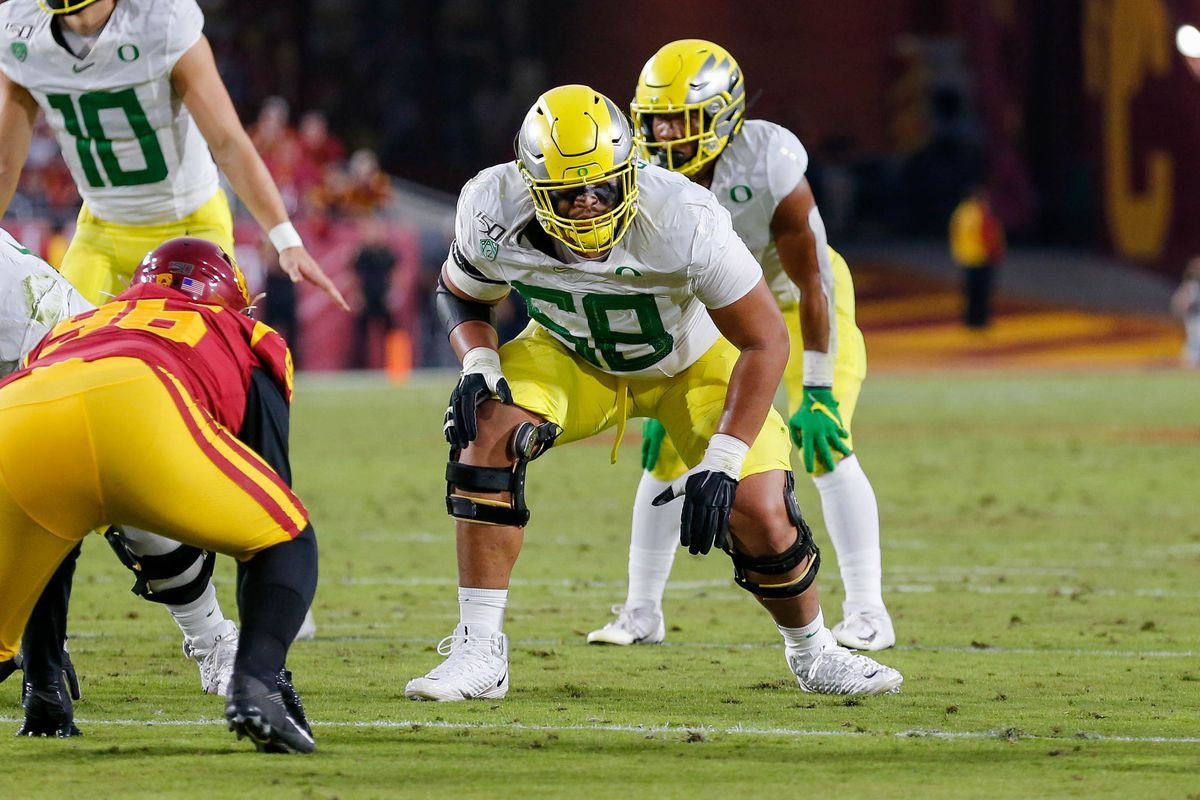
Photo Credit: Jordon Kelly/Icon Sportswire via Getty Images
For tackles, evaluation has to start with pass protection, and this in turn has to start with foot speed. Sewell isn’t in the very top tier in this regard, unsurprising really given he weighs in at over 330lbs, but he is still able to cover around the edge effectively against most speed rushers:
He also shows a really nice ability to mirror laterally while keeping his weight over his feet:
In terms of what he can be as a pass protector in terms of his lower body, there is certainly a lot to like. However, currently he does struggle with the consistency of his knee bend quite a lot, which makes it hard for him to open his hips and recover laterally when rushers are able to get past his outside shoulder:
This can also lead to him having to lean forwards into blocks in order to match pad level:
Which leads to issues controlling blocks and can lead to him getting worked around by better technical rushers. The biggest issue this creates, however, is with his balance, as the poor knee bend leads to his weight getting quite high and, while he was able to counter this with great strength to some degree, he gets worked off-balance on a more consistent basis:
Very few offensive linemen play with ideal knee bend, but Sewell’s is actively quite poor at this point a lot of the time and while this is definitely something he can work on and improve at, it is something that could get him into trouble early on.
He is also sometimes a little guilty of over-setting at times, something which has been a persistent issue for Greg Little so far in his career, and while this should be something that can be coached out of him, he can’t afford to give defenders easy wins like these:
The consistency and discipline of his footwork is currently Sewell’s biggest issue in pass protection. These are things that can be coached and worked on, but improvement shouldn’t be taken for granted.
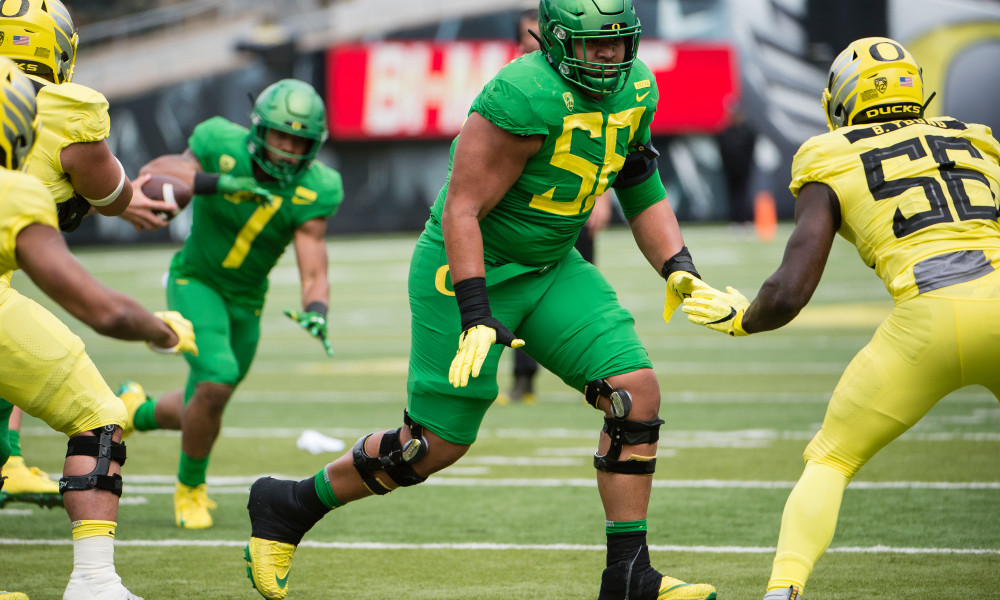
Apr 20, 2019; Eugene, OR, USA; Oregon Ducks offensive lineman Penei Sewell (58) blocks a defender during the Oregon spring game at Autzen Stadium. Mighty Oregon beat Fighting Ducks 20-13. Mandatory Credit: Troy Wayrynen-USA TODAY Sports
Where Sewell is able to make up for this somewhat is with his hand usage. While he doesn’t have ideal arm length, he has great upper body strength and does a really good job of locating his hands inside:
He is then able to use this effectively by hard-setting and taking space away from defenders and looking to get inside hand placement and taking them out of the play early:
This is not something that he can do every play, but by using it selectively he is able to use his biggest positives (his strength and his hand placement) to his advantage while also masking his lack of elite foot speed.
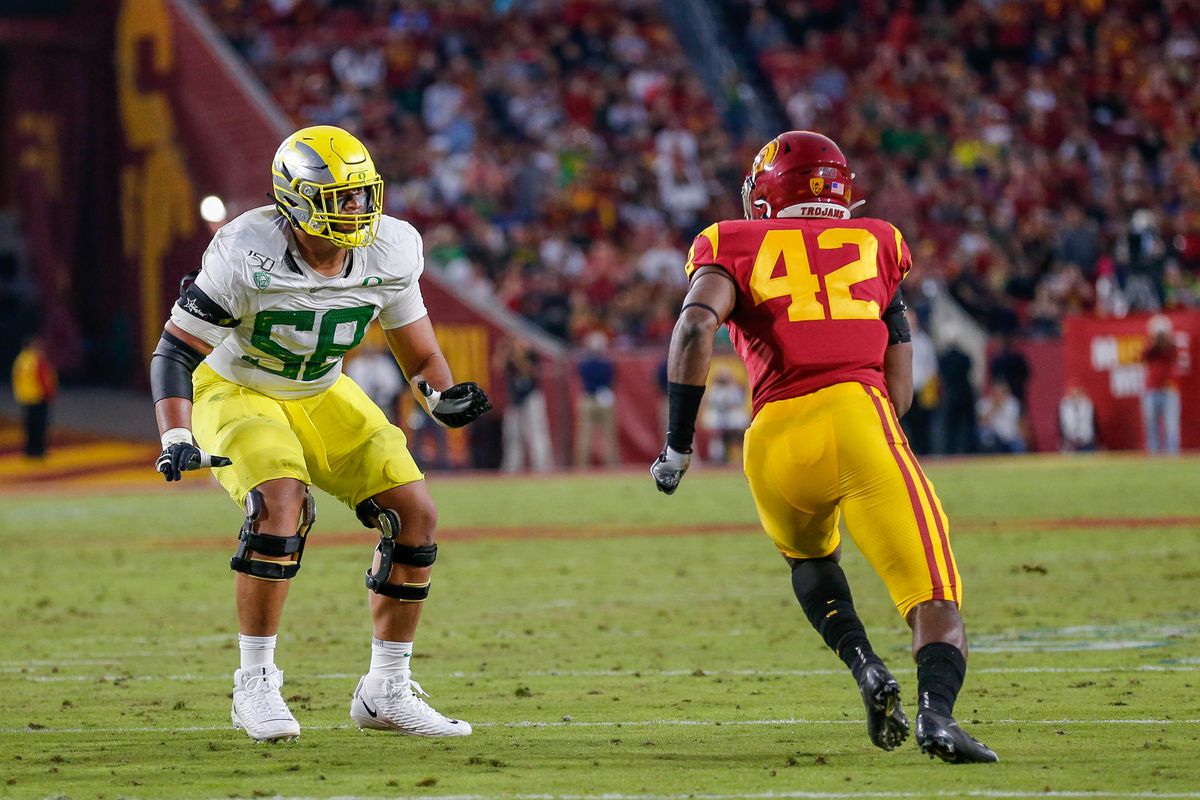
Photo Credit: Jordon Kelly/Icon Sportswire via Getty Images
The final thing to consider with regards to the passing game is his ability to impact the game on screens. He certainly moves extremely well for a player of his size and when it works well, he jumps off the screen:
However, here as well he can struggle for knee bend and this can lead to some leans and whiffs:
Overall, Sewell has things to work on, especially in terms of his knee bend, but he has a combination of quickness, agility and power to be an excellent pass protector if he puts it together. That being said, his value as a pass protector is strongly linked to being able to make further improvements, as for all the talent he has, he is going to lose a number of reps early on if he continues to play with such inconsistent balance and control.
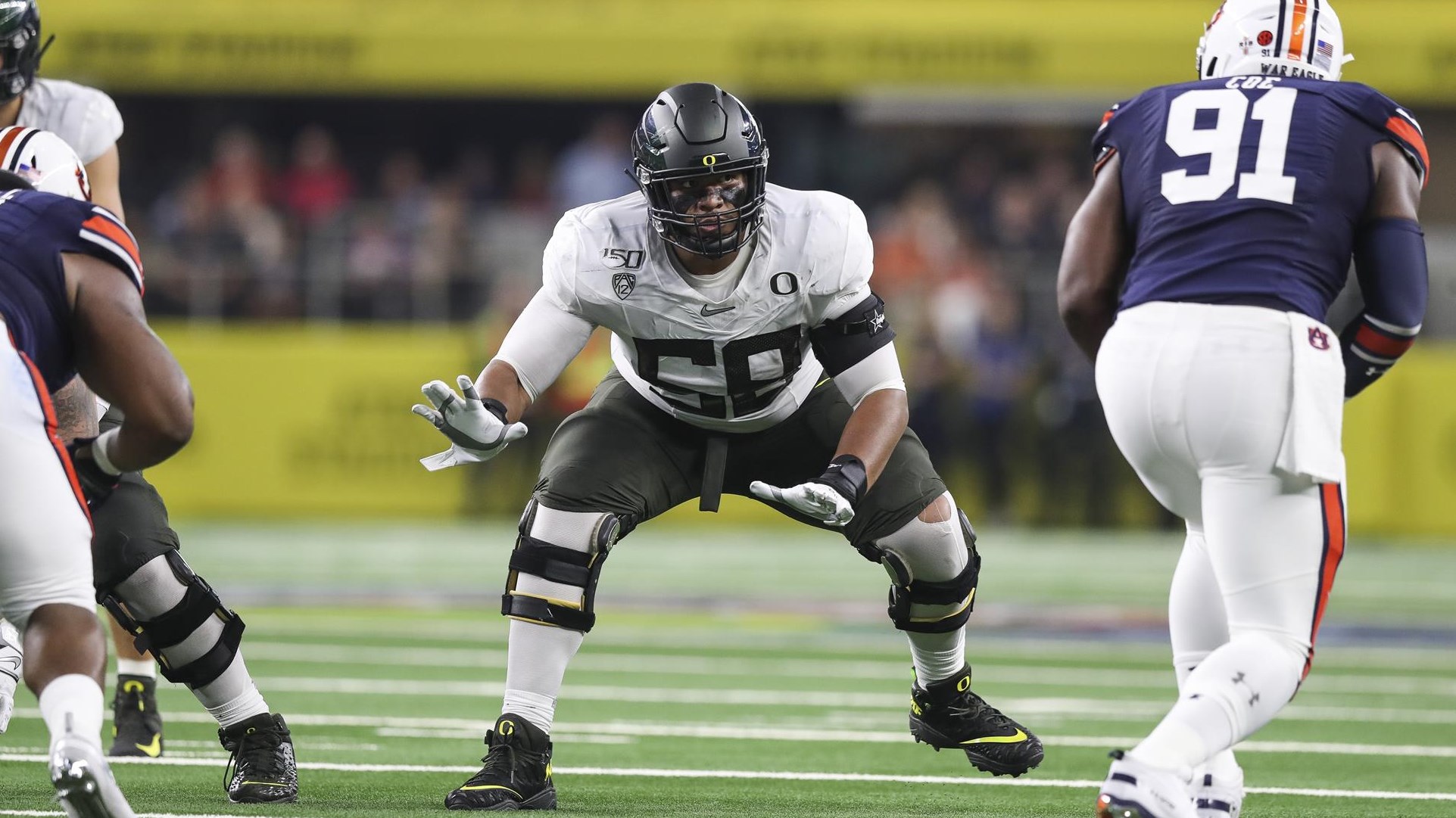
Photo Credit: University of Oregon Athletics
In the run game, Sewell’s power certainly shows up with an ability to move defenders backwards and create easy yardage for running backs working behind him:
However, as much upside as he has in this regard, his lower body once again lets him down a little too often. He plays with too straight legs which negates a lot of his power and allows defenders to drive under his pads to get penetration:
This in turn leads to him having to lean into blocks to match pad level, as was the case in the passing game, which makes it very hard for him to control blocks laterally:
Which is made worse by the way that straight legs naturally lead him to narrow his base:
As in the passing game then, Sewell has a ton of talent but struggles to play with consistent balance and control which leads to move whiffs than are ideal and make it hard for him to make the most out of the talent he does have.
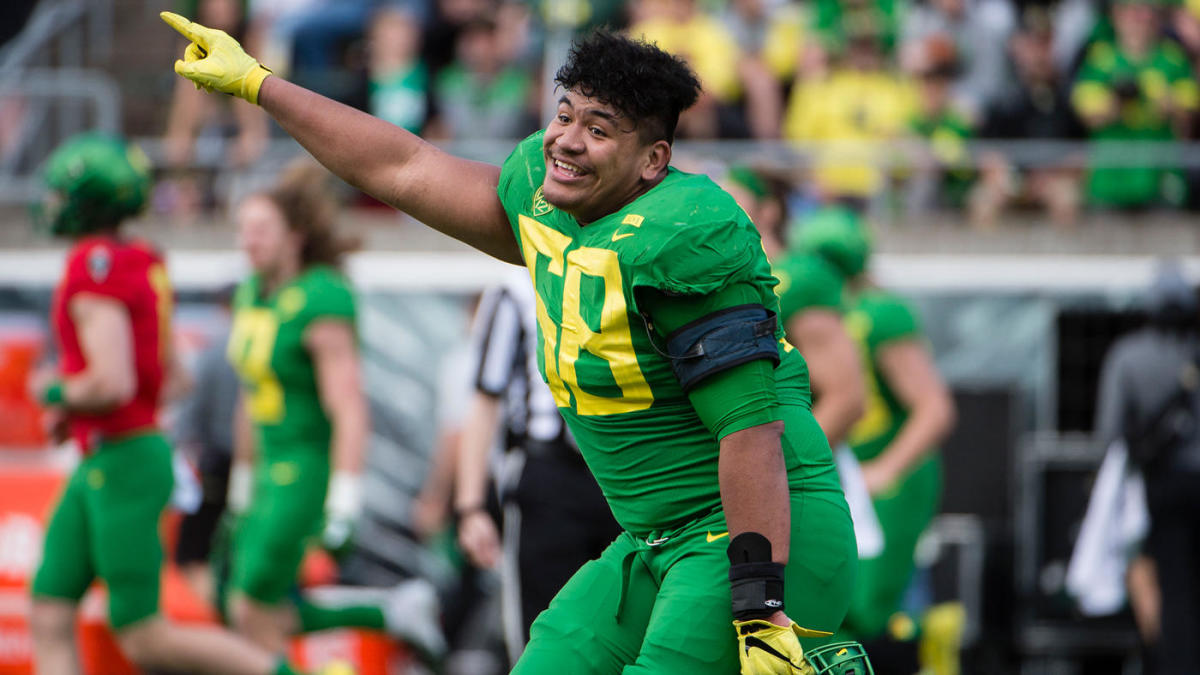
Photo Credit: Troy Wayrynen
As in the passing game, he does make up for some of his balance issues with good hand placement, but ultimately as long as he spends a lot of time off balance he is going to struggle to secure blocks on a consistent basis without risking holding calls:
Where Sewell also should be better is working to the second level, as while he does get up the field well his high pad level leads to him whiffing far too often:
It would be unfair to say that Sewell isn’t a good run blocker, as with his power and hand placement he is able to be an effective player a lot of the time, but what he isn’t right now is a particularly consistent run blocker with too many whiffs when blocking on the front side and too much penetration allowed when blocking on the back side of plays. As in the passing game, he has the talent to be elite, but needs to put it to more consistent basis.
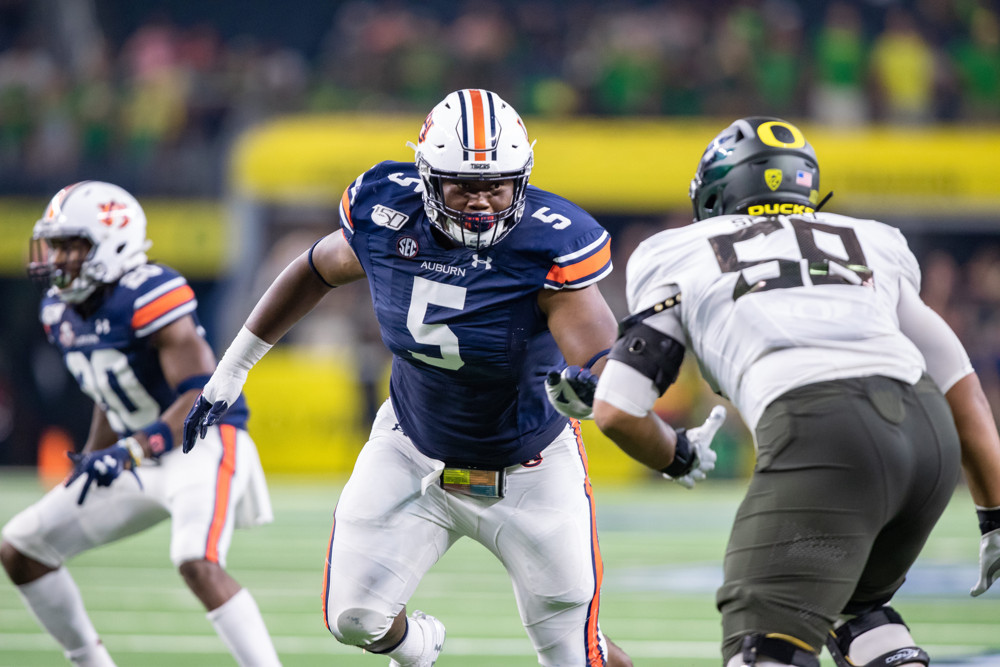
ARLINGTON, TX – AUGUST 31: Auburn Tigers defensive tackle Derrick Brown (#5) tries to work around the block of Oregon Ducks offensive tackle Penei Sewell (#58) during the Advocare Classic College Football game between the Auburn Tigers and the Oregon Ducks on August 31, 2019 at AT&T Stadium in Arlington, Texas. (Photo by Matthew Visinsky)
To be clear, Sewell’s ceiling is the highest of any tackle in this class, and he has a chance to be one of the very best left tackles in the NFL with time. He is also still just twenty years old and the fact that he hasn’t put it all together from a technical perspective just yet is understandable. Upside wise, he is arguably the top non-quarterback in the class.
However, what he isn’t is the finished product. His lower body lets him down far too often in both pass protection and as a run blocker and if a team rolls him out week one at left tackle he could struggle fairly significantly and will untapped potential there is always the risk that it can never be tapped.
For the Panthers, Sewell could be their left tackle for the next decade, but he is a player they need to trust in terms of coachability and continued development in order to take in the top ten. He can be great, but right now he’s not a reliable starter.
(Top photo via Brian Rothmuller/Icon Sportswire via Getty Images)

